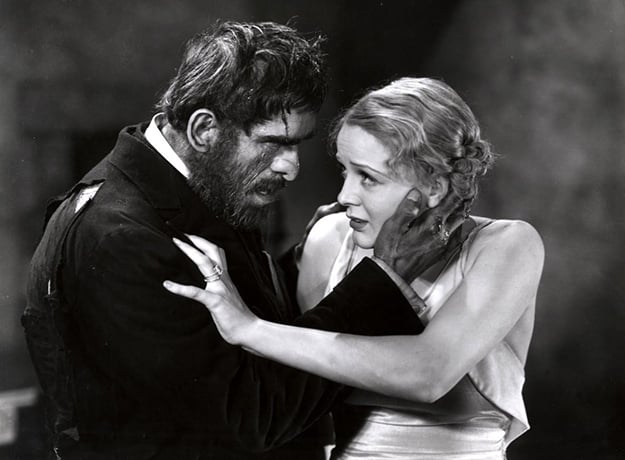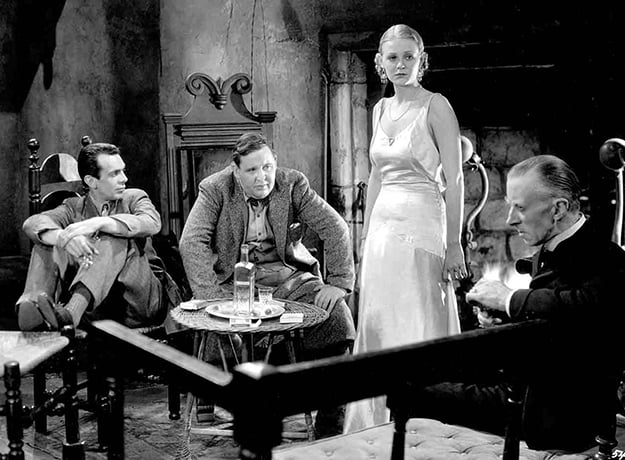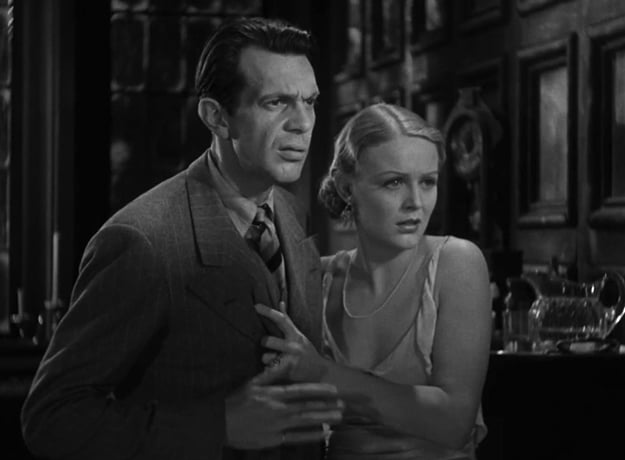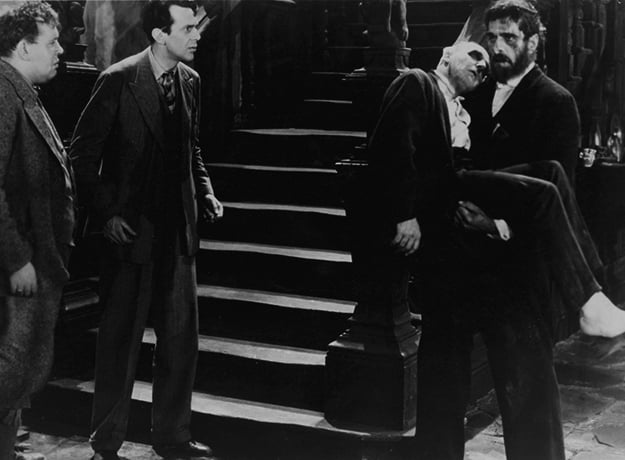Deep Focus: The Old Dark House

In James Whale’s least-seen masterpiece, The Old Dark House (1932), a landslide in a rainstorm forces a handful of urban sophisticates off a country road in Wales. They find shelter in a rambling manse, and heart-stopping comedy-drama with its perverse inmates. A deaf religious fanatic, Rebecca Femm (Eva Moore), owns the title edifice; her desiccated brother Horace (Ernest Thesiger), hiding from police, presents the only civil face to strangers; a lurching, crazily scarred mute, Morgan (Boris Karloff), serves as family handyman, butler, and thug; and in a third-story bedroom the siblings’ 102-year-old father, Sir Roderick Femm (Elspeth Dudgeon, billed as “John”), wastes away, dreaming of bacchanals back in the day.
Mysterious people locked away in upstairs rooms had been a staple of Gothic fiction since before Jane Eyre, and silent hits like The Bat and The Cat and the Canary had combined laughs and shocks in mysterious mansions. Whale upped the ante on all of them when he made this movie. It’s a jet-black comedy about rural reactionaries shocking metropolitans out of complacency, flippancy, and existential paralysis. Thoroughly and blessedly unpretentious, utterly rooted in its time and place, it nonetheless takes on the patina of a fable.
Still the wittiest example of the genre that took its name, The Old Dark House assumes glittering and sometimes rabid new life in a first-class 4K restoration, screening on September 30 at the New York Film Festival. Suddenly, we can see every gray or ebony strip in the latticework of aged wood and smoke-stained plaster and billowing shadows that Whale and his team (cinematographer Arthur Edeson and art director Charles D. Hall) built into their production design. So when some bright young things pierce the darkness, they’re akin to licks of flames.

This is high camp played as hard-edged satire and claustrophobic high adventure. The Old Dark House is as entertaining as it was in 1932, partly because its villains include a moralistic zealot, a white-collar criminal, an out-of-control brute, and an aging, hollowed-out hedonist. Whale and his screenwriter, Benn W. Levy, working from the young J.B. Priestley’s first-rate thriller Benighted, put us right inside the bouncing car with the first set of slickers, Philip and Margaret Waverton (Raymond Massey and Gloria Stuart) and Penderel (Melvyn Douglas). The married couple bicker as they motor through an incessant downpour; Penderel croons “Singing in the Bathtub” and remains blasé, even when they barely escape a hill collapsing behind them. They’re so desperate for dry warmth and so secure in their own skins that they don’t flinch at Morgan when he answers the door, his nose and brow crossed with scars, like the head of a badly stitched giant ragdoll, and his mouth barely moving as he mumbles strange incoherent sounds.
The newcomers represent the Lost Generation, who’ve turned their psychic wounds and disillusion from World War I into a sober kind of glamour (the Wavertons) or uninhibited and sometimes forced gaiety (Penderel). Whale, a Great War veteran who fell in love with theater at a POW camp, treats the material with an alternately ticklish and ferocious touch. When these citizens of the world knock on the heavy, ancient door, they find themselves face to face with robust Dickensian caricatures. The Femms make bold impressions the moment we see them, then continually startle us with their cruelty and quirks. In a hilariously punctilious performance, Thesiger invests Horace with sardonic hauteur. He establishes the film’s deadpan humor when he picks up a bouquet and says, “My sister was on the point of arranging these flowers,” then blithely tosses them into the fire. It’s safe to say that only Thesiger could have turned “Have a potato” into an indelible catchphrase. Eva Moore, as Rebecca, embodies the crudeness and ugliness beneath high-minded self-denial. It’s as funny as it is upsetting to hear her repeat that she has “No beds!” for her guests, or to see her snatch pickled onions onto her dinner plate, then shovel them into her mouth.
When Rebecca walks Margaret into her cluttered, stuffy bedroom so she can change out of her wet clothes, the reluctant hostess terrifies her worldly guest. After observing the svelte young woman getting into a slinky, low-cut cocktail gown, Rebecca fingers the satin and says, “Fine stuff, but it will rot.” Then she points a bony digit at Margaret, presses a hammy hand atop her chest, and says, “Finer stuff still, but it’ll rot, too.” This movie portrays sexual repression and frustration as one creeping disease. Karloff’s Morgan must have been a model for Charles Addams’s slapstick Lurch, but he’s also genuinely horrible—with his lascivious glare and grabby hands, he puts the id into idiot. The old relic Sir Roderick proves to be comparatively levelheaded when we finally meet him. He’s a parched, pajama-clad specter, with an eerie, high-pitched whisper of a voice, puckered skin, and long white hair that seems to grow in and out of his pillow. Whale’s biographer, James Curtis, reports that the director cast Elspeth Dudgeon in the part because he couldn’t find a male actor who could look as believably antique. (Whale billed her as John.) This cross-dressing stroke of genius was a casting coup, not just an in-joke.

The beautifully wrought script enables Whale to exploit Priestley’s wittiest dialogue while breathing his own hyperbolic atmosphere into the airtight structure. Just when Whale gleefully exhausts all the culture-clash possibilities, the storm blows new blood into the house: blustery Sir William Porterhouse (Charles Laughton), who’s filled with class resentment despite being a self-made tycoon, and good-hearted, gold-digging Gladys (Lillian Bond), a sympathetic but not overly talented chorus girl. These characters bring the vibrancy of the music hall into the mix. Gladys performs an exuberant burlesque of a German folk dance when Penderel lends her a pair of his dry shoes. The movie gets more enjoyable with every new character. This odd couple allows Rebecca to proclaim once more “No beds!” and Horace to intone again, “Have a potato.” These two also suggest ways out of despair—Bond’s Gladys via empathy and love, Laughton’s Sir William via energy and industry. Has any actor ever made pathos this enjoyable? Laughton out-shouts the wind when he’s trying to will everyone into having a good time, himself included. He’s also stirring when he explains that he became a millionaire baronet to avenge the snubbing of his late wife. For her part, Bond’s exuberance casts a spell on us as well as Penderel. Gladys levels with everyone about the reasons she serves as William’s escort—he’s nice to her and he’s got money. But she waxes poetic when she senses that Penderel is a man out of time, resisting the hard drive and hustle a person needs to get ahead in the 20th century. We’re so taken with these characters we don’t notice how skillfully Whale sets the screen for disaster. The movie hits the spook-house trifecta just a third of the way in. Morgan grows dangerously drunk, a menacing cackle emanates from way upstairs, and the electricity flickers off for good.
The director’s nimble, witty style generates its own electricity. It’s equally fantastical and observant. The house’s wind-swept corridor, with curtains blowing like wraiths, presages the hallway in Beauty and the Beast. Early on, once Margaret thinks she’s safe to change clothes in Rebecca’s bedroom, the restored print enables us to savor the puritanical décor. It includes a framed photograph of Queen Victoria, the sampler reading “Let There Be Light” (though Rebecca abhors artificial light), and a warped three-paneled vanity mirror that reflects grotesque distortions of Rebecca’s already pudgy and misshapen visage. With exhilarating confidence, Whale does figure-eights around objective and subjective reality. When he replays those ghastly multiple images of Rebecca, along with a close-up of Morgan’s damaged face, he puts us straight inside the head of a panicked Mrs. Waverton. Some of his greatest touches derive from Priestley’s book, including Rebecca placing her hand “just above [Margaret’s] right breast,” or Morgan “pointing impressively to the floor” to indicate that the house rests on a giant rock. Whale brings them off cinematically, not just to the hilt but past it, all the way to the pommel. Rebecca’s invasion of Margaret’s space becomes even more horrifying when Whale restages it in the shadows the fireplace casts against the dining hall. The camera climbing down Karloff’s long, thick legs as Morgan gestures to the floor gives that solid gesture a kinetic frisson.
Whale’s uncanny ability to balance dynamic storytelling with outsize performances, textured dialogue, and flamboyant production design enables him to wring dark humor from each fraught situation. Why does Rebecca shut Horace up when he starts to mention a name that sounds like “Saul?” Why does Horace balk at helping Philip Waverton retrieve a lamp on the third-story landing? What kind of hold does Morgan have on both of them? Whale does such a superb job that we share the city characters’ hopes, confusions, and terrors even when we laugh at the story’s giddy excesses. We want the Wavertons to mend their obvious troubles as they brave the dark at the top of the stair. We root for Penderel and Gladys to pair off and for Sir William to act as their fairy godfather.

When Whale unleashes his ultimate surprise, he pulls off the novel’s vision of self-immolating nihilism. In Frankenstein, Whale conjured nightmarish visions of peasants marching on Frankenstein’s monster with pitchforks and torches. Here he wrings similar tension from one wild-eyed man wielding a log drawn from the fireplace. The movie is a laugh riot and a real riot. Like a pop-art T.S. Eliot, it shows us fear in a handful of dust—and embers.
The Old Dark House screens in a new restoration on Saturday, September 30, in the New York Film Festival. Addendum: The restoration begins a run at Quad Cinema on October 6.
Michael Sragow is a contributing editor to Film Comment and writes its Deep Focus column. He is a member of the National Society of Film Critics and the Los Angeles Film Critics Association. He also curates “The Moviegoer” at the Library of America website.







